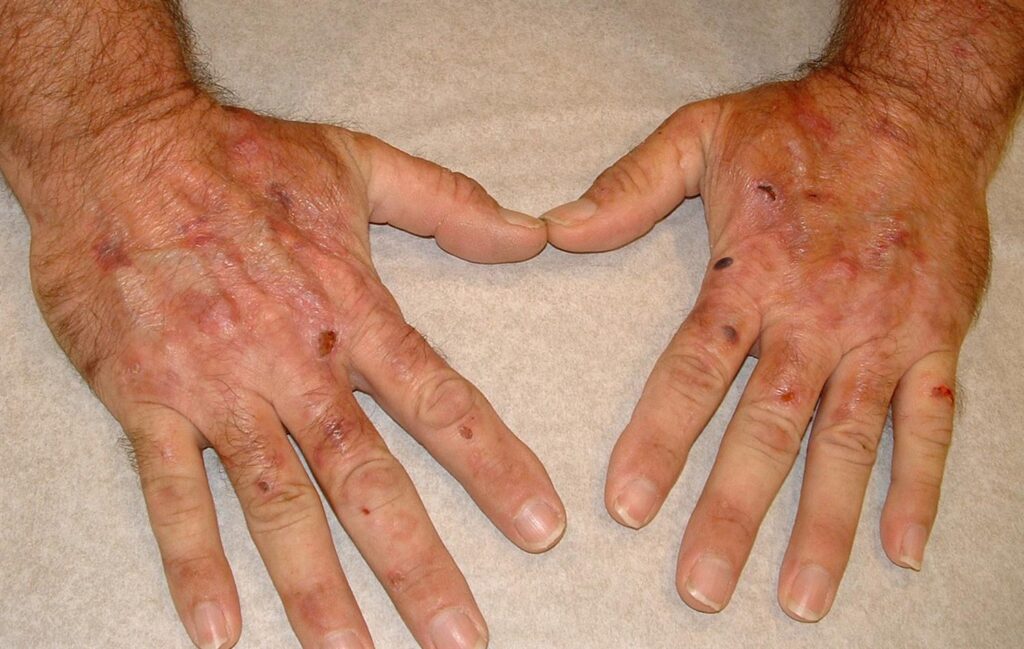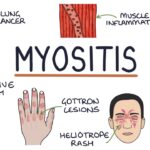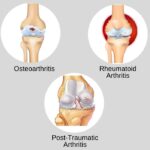Porphyria cutanea tarda (PCT) is the most prevalent form of hepatic porphyria, a group of metabolic disorders resulting from enzyme deficiencies in the heme biosynthetic pathway. PCT is specifically caused by a deficiency in uroporphyrinogen decarboxylase (UROD), leading to the accumulation of porphyrins in the liver and skin.
The condition is marked by photosensitivity, resulting in fragile skin, blistering, and hyperpigmentation, particularly in sun-exposed areas. As a cutaneous porphyria, PCT manifests primarily through dermatologic symptoms rather than acute neurological crises.

Pathogenesis of Porphyria Cutanea Tarda
PCT arises due to inhibition or deficiency of UROD in the hepatic tissue, causing an accumulation of uroporphyrins and other porphyrin precursors. These photosensitive compounds, when exposed to ultraviolet (UV) light, generate reactive oxygen species that damage surrounding tissues.
There are two major types of PCT:
- Type I (Sporadic): Acquired UROD deficiency, usually triggered by liver injury or iron overload.
- Type II (Familial): Inherited mutations in the UROD gene (autosomal dominant), often requiring additional environmental triggers for clinical manifestation.
Common Causes and Risk Factors
PCT typically develops in adulthood, with triggers that impair liver function or increase iron accumulation, exacerbating UROD deficiency.
Contributing Factors:
- Alcohol consumption
- Iron overload (hemochromatosis)
- Estrogen use (oral contraceptives or hormone therapy)
- Hepatitis C virus (HCV) infection
- HIV infection
- Smoking
- Exposure to certain chemicals or hydrocarbons
Individuals with hereditary hemochromatosis or those carrying the HFE gene mutations (C282Y or H63D) are at heightened risk due to iron dysregulation.
Signs and Symptoms of PCT
The clinical hallmark of porphyria cutanea tarda is chronic photosensitivity, which predominantly affects sun-exposed areas such as the hands, face, neck, and forearms.
Dermatologic Symptoms:
- Fragile skin that bruises or tears easily
- Painful vesicles or bullae (blisters)
- Erosions and crusts from ruptured blisters
- Scarring and milia formation
- Hyperpigmentation and hypopigmentation
- Hypertrichosis (excess facial hair)
Systemic Associations:
While PCT mainly presents with skin symptoms, it is frequently associated with liver dysfunction, especially in the context of viral hepatitis, alcoholism, or iron overload.
Diagnostic Evaluation
Biochemical Testing:
Diagnosis begins with urine and plasma porphyrin analysis:
- Elevated uroporphyrins and heptacarboxylporphyrins
- Fluorescence of urine under Wood’s lamp (pink-orange)
Laboratory Workup:
- Serum ferritin and iron studies (evaluate iron overload)
- Liver function tests (ALT, AST, GGT)
- Viral serologies: HCV, HIV
- UROD enzyme activity (if hereditary PCT suspected)
- Genetic testing for UROD and HFE mutations (Type II PCT or hemochromatosis)
Skin Biopsy (when needed):
- Subepidermal blister
- Minimal inflammatory infiltrate
- Positive periodic acid-Schiff (PAS) staining for basement membrane thickening
Treatment Strategies for Porphyria Cutanea Tarda
Effective management involves both removal of triggers and therapeutic interventions to reduce porphyrin levels and prevent recurrences.
1. Phlebotomy (Venesection)
- Mainstay of treatment
- Goal: Decrease iron stores and inhibit porphyrin production
- Protocol: 500 mL every 1–2 weeks until ferritin < 20–50 ng/mL
2. Low-Dose Hydroxychloroquine or Chloroquine
- Mobilizes porphyrins from the liver
- Dose: 100 mg hydroxychloroquine twice weekly
- Caution: Avoid high doses due to risk of hepatotoxicity
3. Avoidance of Triggers
- Discontinue estrogen therapy
- Reduce or eliminate alcohol intake
- Avoid sun exposure and use protective clothing/sunscreens
- Stop smoking and manage comorbid conditions
4. Antiviral Therapy
- Treat underlying HCV or HIV infections as indicated
Monitoring and Follow-Up
Patients undergoing treatment for PCT require regular monitoring to assess response and detect relapses.
Monitoring Parameters:
- Serum ferritin levels
- Liver function tests
- Urinary porphyrin levels
- Screening for hepatocellular carcinoma (if cirrhosis or chronic hepatitis present)
Long-term remission is achievable with consistent treatment, particularly in those with well-controlled iron levels and minimal exposure to exacerbating agents.
Prognosis and Long-Term Outlook
When appropriately managed, the prognosis for PCT is generally favorable. Remission can often be sustained for years, especially with continued avoidance of risk factors. However, untreated or recurrent PCT may lead to chronic liver damage or cirrhosis, underscoring the importance of vigilant follow-up and lifestyle modification.
Porphyria cutanea tarda is a clinically distinct and manageable form of hepatic porphyria. Characterized by photosensitive skin lesions, iron overload, and hepatic involvement, it demands a comprehensive and targeted therapeutic approach. By addressing both biochemical dysfunction and environmental triggers, long-term control and improved quality of life are attainable for affected individuals.

